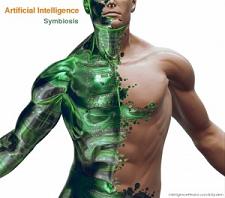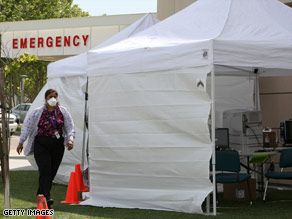Singularity Hub
Create an AI on Your Computer
Written on May 28, 2009 – 11:48 am | by Aaron Saenz |
If many hands make light work, then maybe many computers can make an artificial brain. That’s the basic reasoning behind Intelligence Realm’s Artificial Intelligence project. By reverse engineering the brain through a simulation spread out over many different personal computers, Intelligence Realm hopes to create an AI from the ground-up, one neuron at a time. The first waves of simulation are already proving successful, with over 14,000 computers used and 740 billion neurons modeled. Singularity Hub managed to snag the project’s leader, Ovidiu Anghelidi, for an interview: see the full text at the end of this article.
The ultimate goal of Intelligence Realm is to create an AI or multiple AIs, and use these intelligences in scientific endeavors. By focusing on the human brain as a prototype, they can create an intelligence that solves problems and “thinks” like a human. This is akin to the work done at FACETS that Singularity Hub highlighted some weeks ago. The largest difference between Intelligence Realm and FACETS is that Intelligence Realm is relying on a purely simulated/software approach.
Which sort of makes Intelligence Realm similar to the Blue Brain Project that Singularity Hub also discussed. Both are computer simulations of neurons in the brain, but Blue Brain’s ultimate goal is to better understand neurological functions, while Intelligence Realm is seeking to eventually create an AI. In either case, to successfully simulate the brain in software alone, you need a lot of computing power. Blue Brain runs off a high-tech supercomputer, a resource that’s pretty much exclusive to that project. Even with that impressive commodity, Blue Brain is hitting the limit of what it can simulate. There’s too much to model for just one computer alone, no matter how powerful. Intelligence Realm is using a distributed computing solution. Where one computer cluster alone may fail, many working together may succeed. Which is why Intelligence Realm is looking for help.
The AI system project is actively recruiting, with more than 6700 volunteers answering the call. Each volunteer runs a small portion of the larger simulation on their computer(s) and then ships the results back to the main server. BOINC, the Berkeley built distributed computing software that makes it all possible, manages the flow of data back and forth. It’s the same software used for SETI’s distributed computing processing. Joining the project is pretty simple: you just download BOINC, some other data files, and you’re good to go. You can run the simulation as an application, or as part of your screen saver.
Baby Steps
So, 6700 volunteers, 14,000 or so platforms, 740 billion neurons, but what is the simulated brain actually thinking? Not a lot at the moment. The same is true with the Blue Brain Project, or FACETS. Simulating a complex organ like the brain is a slow process, and the first steps are focused on understanding how the thing actually works. Inputs (Intelligence Realm is using text strings) are converted into neuronal signals, those signals are allowed to interact in the simulation and the end state is converted back to an output. It’s a time and labor (computation) intensive process. Right now, Intelligence Realm is just building towards simple arithmetic.
Which is definitely a baby step, but there are more steps ahead. Intelligence Realm plans on learning how to map numbers to neurons, understanding the kind of patterns of neurons in your brain that represent numbers, and figuring out basic mathematical operators (addition, subtraction, etc). From these humble beginnings, more complex reasoning will emerge. At least, that’s the plan.
Intelligence Realm isn’t just building some sort of biophysical calculator. Their brain is being designed so that it can change and grow, just like a human brain. They’ve focused on simulating all parts of the brain (including the lower reasoning sections) and increasing the plasticity of their model. Right now it’s stumbling towards knowing 1+1 = 2. Even with linear growth they hope that this same stumbling intelligence will evolve into a mental giant. It’s a monumental task, though, and there’s no guarantee it will work. Building artificial intelligence is probably one of the most difficult tasks to undertake, and this early in the game, it’s hard to see if the baby steps will develop into adult strides. The simulation process may not even be the right approach. It’s a valuable experiment for what it can teach us about the brain, but it may never create an AI. A larger question may be, do we want it to?
Knock, Knock…It’s Inevitability
With the newest Terminator movie out, it’s only natural to start worrying about the dangers of artificial intelligence again. Why build these things if they’re just going to hunt down Christian Bale? For many, the threats of artificial intelligence make it seem like an effort of self-destructive curiosity. After all, from Shelley’s Frankenstein Monster to Adam and Eve, Western civilization seems to believe that creations always end up turning on their creators.
AI, however, promises rewards as well as threats. Problems in chemistry, biology, physics, economics, engineering, and astronomy, even questions of philosophy could all be helped by the application of an advanced AI. What’s more, as we seek to upgrade ourselves through cybernetics and genetic engineering, we will become more artificial. In the end, the line between artificial and natural intelligence may be blurred to a point that AIs will seem like our equals, not our eventual oppressors. However, that’s not a path that everyone will necessarily want to walk down.

Will AI and Humans learn to co-exist?
The nature of distributed computing and BOINC allow you to effectively vote on whether or not this project will succeed. Intelligence Realm will eventually need hundred of thousands if not millions of computing platforms to run their simulations. If you believe that AI deserves a chance to exist, give them a hand and recruit others. If you think we’re building our own destroyers, then don’t run the program. In the end, the success or failure of this project may very well depend on how many volunteers are willing to serve as mid-wives to a new form of intelligence.
Before you make your decision though, make sure to read the following interview. As project leader, Ovidiu Anghelidi is one of the driving minds behind reverse engineering the brain and developing the eventual AI that Intelligence Realm hopes to build. He’s didn’t mean for this to be a recruiting speech, but he makes some good points:
SH: Hello. Could you please start by giving yourself and your project a brief introduction?
OA: Hi. My name is Ovidiu Anghelidi and I am working on a distributed computing project involving thousands of computers in the field of artificial intelligence. Our goal is to develop a system that can perform automated research.
What drew you to this project?
During my adolescence I tried understanding the nature of question. I used extensively questions as a learning tool. That drove me to search for better understanding methods. After looking at all kinds of methods, I kinda felt that understanding creativity is a worthier pursuit. Applying various methods of learning and understanding is a fine job, but finding outstanding solutions requires much more than that. For a short while I tried understanding how creativity is done and what exactly is it. I found out that there is not much work done on this subject, mainly because it is an overlapping concept. The search for creativity led me to the field of AI. Because one of the past presidents of the American Association of Artificial Intelligence dedicated an entire issue to this subject I started pursuing that direction. I looked into the field of artificial intelligence for a couple of years and at some point I was reading more and more papers that touched the subject of cognition and brain so I looked briefly into neuroscience. After I read an introductory book about neuroscience, I realized that understanding brain mechanisms is what I should have done all along, for the past 20 years. To this day I am pursuing this direction.
What’s your time table for success? How long till we have a distributed AI running around using your system?
I have been working on this project for about 3 years now, and I estimate that we will need another 7–8 years to finalize the project. Nonetheless we do not need that much time to be able to use some its features. I expect to have some basic features that work within a couple of months. Take for example the multiple simulations feature. If we want to pursue various directions in different fields (i.e. mathematics, biology, physics) we will need to set up a simulation for each field. But we do not need to get to the end of the project, to be able to run single simulations.
Do you think that Artificial Intelligence is a necessary step in the evolution of intelligence? If not, why pursue it? If so, does it have to happen at a given time?
I wouldn’t say necessary, because we don’t know what we are evolving towards. As long as we do not have the full picture from beginning to end, or cases from other species to compare our history to, we shouldn’t just assume that it is necessary.
We should pursue it with all our strength and understanding because soon enough it can give us a lot of answers about ourselves and this Universe. By soon I mean two or three decades. A very short time span, indeed. Artificial Intelligence will amplify a couple of orders of magnitude our research efforts across all disciplines.
In our case it is a natural extension. Any species that reaches a certain level of intelligence, at some point in time, they would start replicating and extending their natural capacities in order to control their environment. The human race did that for the last couple thousands of years, we tried to replicate and extend our capacity to run, see, smell and touch. Now it reached thinking. We invented vehicles, television sets, other devices and we are now close to have artificial intelligence.
What do you think are important short term and long term consequences of this project?
We hope that in short term we will create some awareness in regards to the benefits of artificial intelligence technology. Longer term it is hard to foresee.
How do you see Intelligence Realm interacting with more traditional research institutions? (Universities, peer reviewed Journals, etc)
Well…, we will not be able to provide full details about the entire project because we are pursuing a business model, so that we can support the project in the future, so there is little chance of a collaboration with a University or other research institution. Down the road, as we we will be in an advanced stage with the development, we will probably forge some collaborations. For the time being this doesn’t appear feasible. I am open to collaborations but I can’t see how that would happen.
I submitted some papers to a couple of journals in the past, but I usually receive suggestions that I should look at other journals, from other fields. Most of the work in artificial intelligence doesn’t have neuroscience elements and the work in neuroscience contains little or no artificial intelligence elements. Anyway, I need no recognition.
Why should someone join your project? Why is this work important?
If someone is interested in artificial intelligence it might help them having a different view on the subject and seeing what components are being developed over time. I can not tell how important is this for someone else. On a personal level, I can say that because my work is important to me and by having an AI system I will be able to get answers to many questions, I am working on that. Artificial Intelligence will provide exceptional benefits to the entire society.
What should someone do who is interested in joining the simulation? What can someone do if they can’t participate directly? (Is there a “write-your-congressman” sort of task they could help you with?)
If someone is interested in joining the project they need to download the Boinc client from the http://boinc.berkeley.edu site and then attach to the project using the master Url for this project, http://www.intelligencerealm.com/aisystem. We appreciate the support received from thousands of volunteers from all over the world.
If someone can’t participate directly I suggest to him/her to keep an open mind about what AI is and how it can benefit them. He or she should also try to understand its pitfalls.
There is no write-your-congressman type of task. Mass education is key for AI success. This project doesn’t need to be in the spotlight.
What is the latest news?
We reached 14,000 computers and we simulated over 740 billion neurons. We are working on implementing a basic hippocampal model for learning and memory.
Anything else you want to tell us?
If someone considers the development of artificial intelligence impossible or too far into the future to care about, I can only tell him or her, “Embrace the inevitable”. The advances in the field of neuroscience are increasing rapidly. Scientists are thorough.
Understanding its benefits and pitfalls is all that is needed.
Thank you for your time and we look forward to covering Intelligence Realm as it develops further.
Thank you for having me.
]]>
 A younger science than physics, biology is more linear and less exotic than its older sibling. Whereas physics is (mostly) elegant and symmetric, biology is lunging and ungainly, bound to the material and macroscopic. Its predictions are more specific, its theories less sweeping. And yet, in the end, the exploration of life is the frontier that matters the most. Life gives meaning to all elegant theories and contraptions, life is where the worlds of cosmology and ethics intersect.
A younger science than physics, biology is more linear and less exotic than its older sibling. Whereas physics is (mostly) elegant and symmetric, biology is lunging and ungainly, bound to the material and macroscopic. Its predictions are more specific, its theories less sweeping. And yet, in the end, the exploration of life is the frontier that matters the most. Life gives meaning to all elegant theories and contraptions, life is where the worlds of cosmology and ethics intersect.

